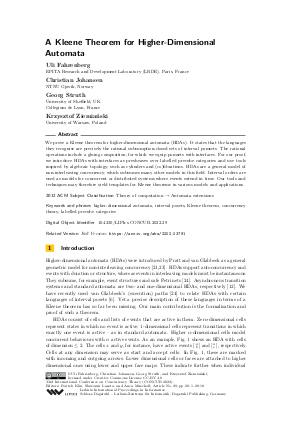A Kleene Theorem for Higher-Dimensional Automata
Authors Uli Fahrenberg, Christian Johansen, Georg Struth, Krzysztof Ziemiański
-
Part of:
Volume:
33rd International Conference on Concurrency Theory (CONCUR 2022)
Part of: Series: Leibniz International Proceedings in Informatics (LIPIcs)
Part of: Conference: International Conference on Concurrency Theory (CONCUR) - License:
 Creative Commons Attribution 4.0 International license
Creative Commons Attribution 4.0 International license
- Publication Date: 2022-09-06
File

PDF
LIPIcs.CONCUR.2022.29.pdf
- Filesize: 0.73 MB
- 18 pages
Document Identifiers
Related Versions
- Full Version https://arxiv.org/abs/2202.03791
Subject Classification
ACM Subject Classification
- Theory of computation → Automata extensions
Keywords
- higher-dimensional automata
- interval posets
- Kleene theorem
- concurrency theory
- labelled precube categories
Metrics
- Access Statistics
-
Total Accesses (updated on a weekly basis)
0Document
0Metadata
Abstract
We prove a Kleene theorem for higher-dimensional automata (HDAs). It states that the languages they recognise are precisely the rational subsumption-closed sets of interval pomsets. The rational operations include a gluing composition, for which we equip pomsets with interfaces. For our proof, we introduce HDAs with interfaces as presheaves over labelled precube categories and use tools inspired by algebraic topology, such as cylinders and (co)fibrations. HDAs are a general model of non-interleaving concurrency, which subsumes many other models in this field. Interval orders are used as models for concurrent or distributed systems where events extend in time. Our tools and techniques may therefore yield templates for Kleene theorems in various models and applications.
Cite As Get BibTex
Uli Fahrenberg, Christian Johansen, Georg Struth, and Krzysztof Ziemiański. A Kleene Theorem for Higher-Dimensional Automata. In 33rd International Conference on Concurrency Theory (CONCUR 2022). Leibniz International Proceedings in Informatics (LIPIcs), Volume 243, pp. 29:1-29:18, Schloss Dagstuhl – Leibniz-Zentrum für Informatik (2022)
https://doi.org/10.4230/LIPIcs.CONCUR.2022.29
BibTex
@InProceedings{fahrenberg_et_al:LIPIcs.CONCUR.2022.29,
author = {Fahrenberg, Uli and Johansen, Christian and Struth, Georg and Ziemia\'{n}ski, Krzysztof},
title = {{A Kleene Theorem for Higher-Dimensional Automata}},
booktitle = {33rd International Conference on Concurrency Theory (CONCUR 2022)},
pages = {29:1--29:18},
series = {Leibniz International Proceedings in Informatics (LIPIcs)},
ISBN = {978-3-95977-246-4},
ISSN = {1868-8969},
year = {2022},
volume = {243},
editor = {Klin, Bartek and Lasota, S{\l}awomir and Muscholl, Anca},
publisher = {Schloss Dagstuhl -- Leibniz-Zentrum f{\"u}r Informatik},
address = {Dagstuhl, Germany},
URL = {https://drops.dagstuhl.de/entities/document/10.4230/LIPIcs.CONCUR.2022.29},
URN = {urn:nbn:de:0030-drops-170925},
doi = {10.4230/LIPIcs.CONCUR.2022.29},
annote = {Keywords: higher-dimensional automata, interval posets, Kleene theorem, concurrency theory, labelled precube categories}
}
Author Details
References
- Marc Bezem, Thierry Coquand, and Simon Huber. A model of type theory in cubical sets. In Ralph Matthes and Aleksy Schubert, editors, TYPES, volume 26 of Leibniz International Proceedings in Informatics, pages 107-128. Schloss Dagstuhl - Leibniz-Zentrum für Informatik, 2013. URL: https://doi.org/10.4230/LIPIcs.TYPES.2013.107.
- Paul Brunet and Damien Pous. Petri automata. Logical Methods in Computer Science, 13(3), 2017. URL: https://doi.org/10.23638/LMCS-13(3:33)2017.
- Christian Choffrut and Leucio Guerra. Logical definability of some rational trace languages. Mathematical Systems Theory, 28(5):397-420, 1995. URL: https://doi.org/10.1007/BF01185864.
- Manfred Droste. A Kleene theorem for recognizable languages over concurrency monoids. In Serge Abiteboul and Eli Shamir, editors, ICALP, volume 820 of Lecture Notes in Computer Science, pages 388-399. Springer, 1994. URL: https://doi.org/10.1007/3-540-58201-0_84.
-
Uli Fahrenberg. Higher-Dimensional Automata from a Topological Viewpoint. PhD thesis, Aalborg University, Denmark, 2005.

- Uli Fahrenberg, Christian Johansen, Georg Struth, and Krzysztof Ziemiański. Languages of higher-dimensional automata. Mathematical Structures in Computer Science, 31(5):575-613, 2021. URL: https://doi.org/10.1017/S0960129521000293.
- Uli Fahrenberg, Christian Johansen, Georg Struth, and Krzysztof Ziemiański. A Kleene theorem for higher-dimensional automata. CoRR, abs/2202.03791, 2022. URL: http://arxiv.org/abs/2202.03791.
- Uli Fahrenberg, Christian Johansen, Georg Struth, and Krzysztof Ziemiański. Posets with interfaces as a model for concurrency. Information and Computation, 285(B):104914, 2022. URL: https://doi.org/10.1016/j.ic.2022.104914.
- Uli Fahrenberg and Axel Legay. Partial higher-dimensional automata. In Lawrence S. Moss and Pawel Sobocinski, editors, CALCO, volume 35 of Leibniz International Proceedings in Informatics, pages 101-115. Schloss Dagstuhl - Leibniz-Zentrum für Informatik, 2015. URL: https://doi.org/10.4230/LIPIcs.CALCO.2015.101.
- Lisbeth Fajstrup, Eric Goubault, Emmanuel Haucourt, Samuel Mimram, and Martin Raussen. Directed Algebraic Topology and Concurrency. Springer, 2016. URL: https://doi.org/10.1007/978-3-319-15398-8.
-
Peter C. Fishburn. Interval Orders and Interval Graphs: A Study of Partially Ordered Sets. Wiley, 1985.

- Eric Goubault. Labelled cubical sets and asynchronous transition systems: an adjunction. In CMCIM, 2002. URL: http://www.lix.polytechnique.fr/~goubault/papers/cmcim02.ps.gz.
-
Jan Grabowski. On partial languages. Fundamentae Informatica, 4(2):427, 1981.

-
Marco Grandis. Directed algebraic topology: models of non-reversible worlds. New mathematical monographs. Cambridge University Press, 2009.

-
Marco Grandis and Luca Mauri. Cubical sets and their site. Theory and Applications of Categories, 11(8):185-211, 2003.

-
André Joyal, Mogens Nielsen, and Glynn Winskel. Bisimulation from open maps. Information and Computation, 127(2):164-185, 1996.

- Tobias Kappé, Paul Brunet, Bas Luttik, Alexandra Silva, and Fabio Zanasi. On series-parallel pomset languages: Rationality, context-freeness and automata. Journal of Logic and Algebraic Methods in Programming, 103:130-153, 2019. URL: https://doi.org/10.1016/j.jlamp.2018.12.001.
-
Alexander Kurz and Jiří Rosický. Weak factorizations, fractions and homotopies. Applied Categorical Structures, 13(2):141-160, 2005.

- Kamal Lodaya and Pascal Weil. Series-parallel languages and the bounded-width property. Theoretical Computer Science, 237(1-2):347-380, 2000. URL: https://doi.org/10.1016/S0304-3975(00)00031-1.
-
Saunders Mac Lane and Ieke Moerdijk. Sheaves in Geometry and Logic. Springer, 1992.

-
Vaughan R. Pratt. Modeling concurrency with geometry. In POPL, pages 311-322, New York City, 1991. ACM Press.

- Pawel Sobocinski. Relational presheaves, change of base and weak simulation. J. Comput. Syst. Sci., 81(5):901-910, 2015. URL: https://doi.org/10.1016/j.jcss.2014.12.007.
- Rob J. van Glabbeek. Bisimulations for higher dimensional automata. Email message, June 1991. URL: http://theory.stanford.edu/~rvg/hda.
-
Rob J. van Glabbeek. On the expressiveness of higher dimensional automata. Theoretical Computer Science, 356(3):265-290, 2006.

- Walter Vogler. Modular Construction and Partial Order Semantics of Petri Nets, volume 625 of Lecture Notes in Computer Science. Springer, 1992. URL: https://doi.org/10.1007/3-540-55767-9.
- Wiesław Zielonka. Notes on finite asynchronous automata. RAIRO - Theoretical Informatics and Applications, 21(2):99-135, 1987. URL: https://doi.org/10.1051/ita/1987210200991.
